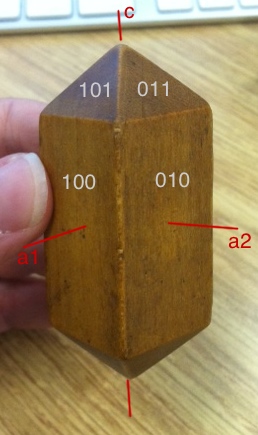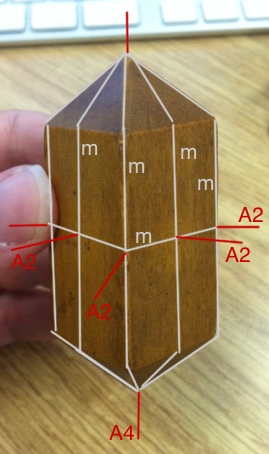WOOSTER, OH – I’m always awed by the beautiful and perfect symmetry of crystals. I can think of no better way to teach external symmetry than with wooden crystal models. The wooden crystal models are a common experience in geology, across generations and continents, although it seems they may be on the endangered list. I’ve chosen to continue using the models in Mineralogy because they allow students to see and “feel” the symmetry operations and our structural geologist thinks the blocks help students with their spatial reasoning skills.
Most people develop a love-hate relationship with the models, but I have to admit I’ve always been infatuated. They’re like logic puzzles with a million different secrets all wrapped up in what seems like a simple wooden block. Spend some time with the block and it will reveal a wealth of information.
This combination of symmetry elements belongs to the point group (or crystal class) 4/m 2/m 2/m. In Hermann-Mauguin notation, 4/m refers to a four-fold rotation axis perpendicular to a mirror. The second and third 2/m terms refer to two-fold rotation axes that are perpendicular to mirrors, one set of axes that exits the crystal in the middle of the faces and another set of axes that exits the crystal on the edges.

The axes (a1, a2, and c) of the tetragonal crystal system align with symmetry elements. Some of the faces have been labeled with their Miller Indices.
The 4/m 2/m 2/m point group belongs to the tetragonal crystal system, which has three mutually perpendicular crystallographic axes. The two horizontal axes (a1 and a2) are equal in length and coincide with the two-fold rotation axes. The vertical axis (c) is longer than the horizontal axes and coincides with the four-fold rotation axis.
Once the crystallographic axes have been determined, we can describe the orientation of the crystal faces using Miller Indices. In short, Miller Indices consist of three numbers (four in the case of hexagonal crystals) that are derived from the intercepts of crystal faces. The crystal face that intersects the a1 axis but parallels the a2 and c axes is assigned a Miller Index of 100. The crystal face that never intersects a1 but cuts both a2 and c is assigned a Miller Index of 011.
We could keep going with this…describing forms, measuring angles, plotting on stereonets, but we won’t. Making it through Miller Indices this week will be enough for the Mineralogy students. Here’s the big secret: this is one of crystals we’re working on in class. I guess we’ll find out which students read the blog on a regular basis!





I had those very same models when I was a student. Your explanations are much better than the ones I had then!
This post made me smile 🙂
Hey Dr. Pollock! Does the four fold/two fold correspond to the subscript in the axes of rotation notation (A_4/A_2)? Or is the subscript supposed to be the total number of axes present in the crystal? And can there not be a horizontal plane of symmetry in the crystal? Or would that be the center of symmetry? See you in class tomorrow!
Nevermind, did the reading for tomorrow and figured it out. Thanks for the post! ^_^
I’ve been revisiting this stuff, although not quite in the same way. Inorganic Chemistry is fun, but not as fun as mineralogy was!
I miss the wooden blocks, they were
I wish that I had you as my prof…..:-)
Pingback: Wooster Geologists » Blog Archive » Early Morning Powdering Session
I teach middle school science and have looked everywhere for a set of crystallography blocks. Do you know if there is a place where they can be bought?
Hi Heather. I can see why you’re having such a hard time finding the wooden crystal models – they’re rare! I found one place that sells plastic models (http://www.shapeways.com/shops/smorf). I also found two websites that have paper models that you print, cut, and fold (http://webmineral.com/help/Forms.shtml#.U_XxabxdWbE) and (http://www.korthalsaltes.com/). Some people mentioned 3-D printing as an option for crystal models, but I’m not sure how that works. Good luck!